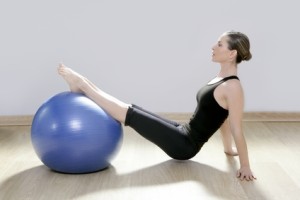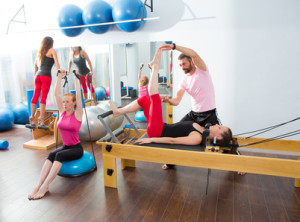For breast cancer survivors using Pilates, it is extremely important to pay attention to the Pilates principles. Getting physical exercise is essential to recovery, but overdoing it can cause more harm than good. Make sure you review the principles below before beginning Pilates for breast cancer recovery, and ask for help from a certified Pilates instructor if you need it.
The 9 Pilates Principles
These principles guide each Pilates exercise to ensure that they are done correctly and safely. In Pilates, less is more. The emphasis is on a correct starting position with proper execution of the exercises; there is no wasted movement in Pilates. No more than five to eight repetitions are completed (except for the Hundreds), and breathing during each exercise is very important. Concentrate on the correct movement patterns first and then add Pilates breathing.
 If you’ve never done Pilates before, this may sound like a lot to think about. If possible, we recommend working with someone who is trained in Pilates first to get you on the right track.
If you’ve never done Pilates before, this may sound like a lot to think about. If possible, we recommend working with someone who is trained in Pilates first to get you on the right track.
- Breathing: Breathing oxygenates the blood and connects the mind and body. Breathing during Pilates will enhance your relaxation, improve your focus, and help to activate your muscles. Pilates breathing is called “rib cage breathing” or costal breathing as the rib cage expands as you inhale and knits together as you exhale. Coordinating the breath with the movement is the goal. This may be difficult at first, but please stay with it. If you get confused, don’t hold your breath—keep breathing!
- Inhale through the nose as if to smell the roses. Place your fingers on your rib cage and feel your rib cage expand.
- Exhale through pursed lips as to blow out candles, drawing the belly in towards your spine. This activates the transverse abdominas muscle. The deeper the exhalation, the more this muscle is activated. Activation of this muscle should feel very gentle, as it is more like a subtle tightening of the abdomen. The lower back and pelvis should remain still. Buttocks and thighs should stay relaxed.
- Concentration: You must place intentional focus on every movement. You will feel each exercise more if you close your eyes, once you become more familiar with the movements. After breast cancer surgery, you may lose the ability to feel if muscles are working properly. Closing your eyes will help in this process to listen to your body and refocus your mind upon proper body movement.
- Control: To be in control means that you maintain the proper form, alignment, and effort during the exercise. You don’t want to throw your body around. If there is jerkiness, shaking, tightness and/or pain you are not in control. You can limit the movement and make it smaller if necessary to regain control.
- Centering: In Pilates, all movements come from the “powerhouse,” or core abdominal muscles. Learning to use the powerhouse correctly will improve your posture, stabilize the spine, and improve your quality of movement. Thus, every exercise is an abdominal exercise. Visualizing a corset around the waist will help you to activate these muscles.
- Precision: Every exercise should be performed with precision and an emphasis upon proper form. Therefore, proper starting position and posture is crucial as well as performing the exercises slowly without momentum.
 Balanced Muscle Development: Everything that is done on one side of the body must also be done on the other side. For example, if you do an exercise with your right arm, you must also do it with your left.
Balanced Muscle Development: Everything that is done on one side of the body must also be done on the other side. For example, if you do an exercise with your right arm, you must also do it with your left.- Rhythm/Flow: All movements in Pilates are done with a sense of rhythm. The movements should be graceful and smooth.
- Whole Body Movement: The whole body is engaged through breathing, engagement of the core, and use of the arms and legs (even though some exercises will not use the arms at all).
- Relaxation: Breathing assists with the relaxation of muscles throughout the body. Unwanted tension should be released prior to beginning the exercises. You may work one body part and relax the others
Written by Naomi Aaronson and Ann Marie Turo. Reprinted with permission from Naomi Aaronson, MA, OTR/L, CHT; Also published on demosHEALTH.
Naomi Aaronson, MA, OTR/L, CHT can be reached at www.recovercisesforwellness.com.

